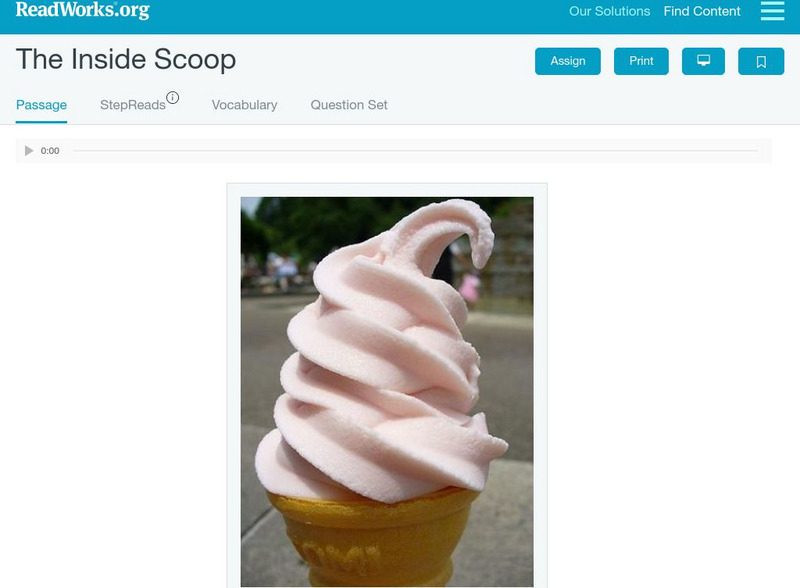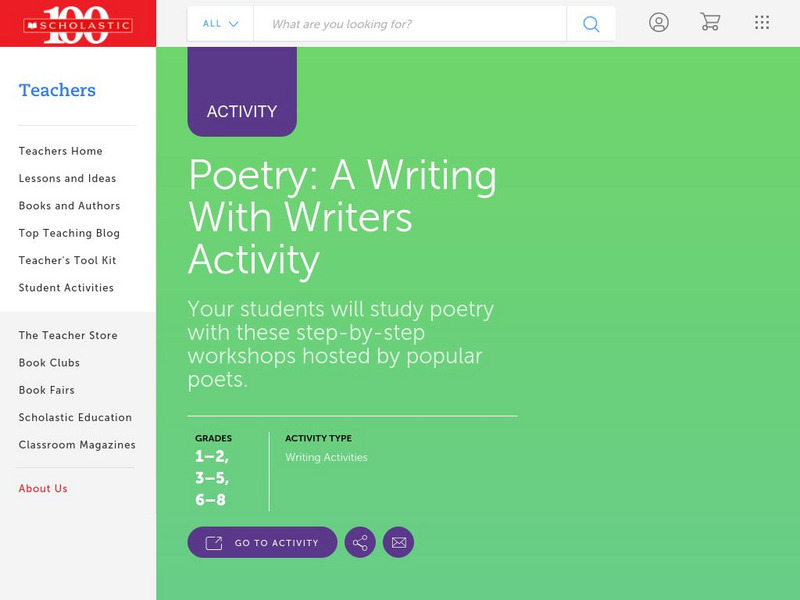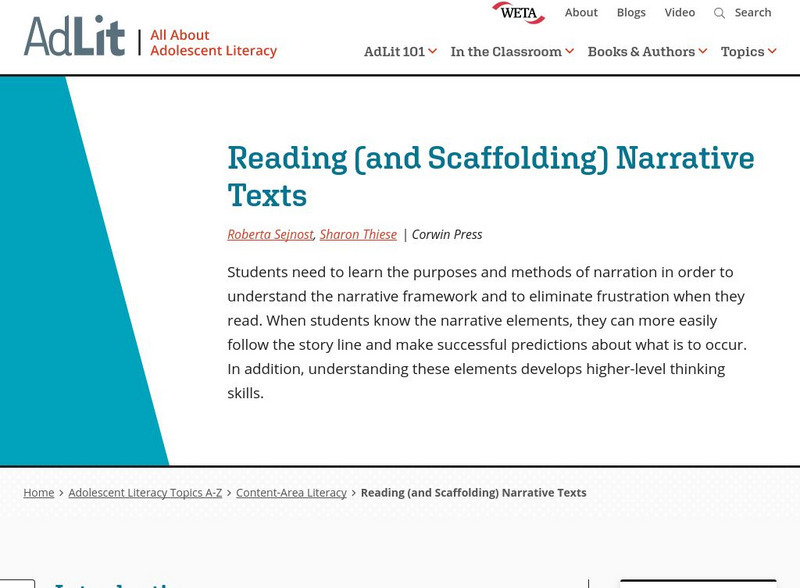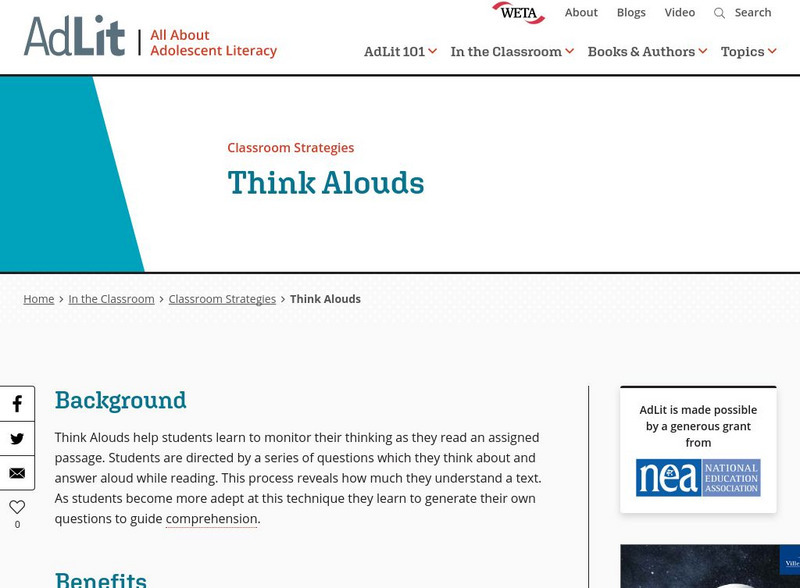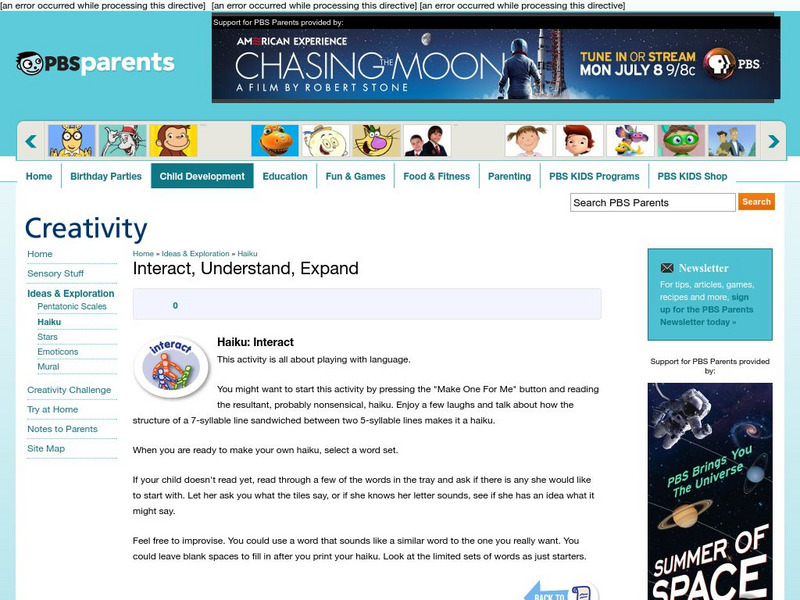Read Works
Read Works: The Inside Scoop
[Free Registration/Login Required] This passages shares the backstory of a couple who own and work on an ice cream truck. This passage is a stand-alone curricular piece that reinforces essential reading skills and strategies and...
Read Works
Read Works: The Growth Factor
[Free Registration/Login Required] This informational text passage shares information about ways to project heighth in students. This passage is a stand-alone curricular piece that reinforces essential reading skills and strategies and...
Scholastic
Scholastic: Poetry: A Writing With Writers Activity
Interactive poetry lessons with well-known authors for three age groups including first through fourth grades with Jack Prelutsky, second through fifth grades with Jean Marzollo, and fourth through eighth grade with Karla Kuskin.
AdLit
Ad lit.org: What's the Big Idea? Integrating Young Adult Literature
Drawing on New York City teachers' experiences, this article examines three ways to effectively integrate young adult literature into the curriculum: use core texts (usually novels, but also other genres as well) that the entire class...
Education Development Center
Tv411: Strategies for Better Reading: Activities 3 of 3
Use these eight multiple choice passages to practice summarizing the main idea of a paragraph.
ReadWriteThink
Read Write Think: Poetry: Sound and Sense
Lesson that gently encourages the teaching of poetry in "nonthreatening" ways. Stresses reading and listening, discussion, and the examination of the sound and sense of poetry.
AdLit
Ad lit.org: Reading (And Scaffolding) Narrative Texts
Students need to learn the purposes and methods of narration in order to understand the narrative framework and to eliminate frustration when they read. When students know the narrative elements, they can more easily follow the story...
ReadWriteThink
Read Write Think: Teaching Poetry Through Riddles
Excellent teaching resource that attempts to teach poetic concepts to middle schoolers by using riddles. Discusses riddles' use of metaphor, simile, and imagery, and relates these concepts to the students' understanding of poetry....
AdLit
Ad lit.org: Classroom Strategies: Think Alouds
Think Alouds help students learn to monitor their thinking as they read an assigned passage. Students are directed by a series of questions which they think about and answer aloud while reading. This process reveals how much they...
AdLit
Ad lit.org: Why Students Think They Understand When They Don't
Students often think they understand a body of material and, believing that they know it, stop trying to learn more. But come test time, it turns out they really don't know the material very well at all. Can cognitive science tell us...
AdLit
Ad lit.org: Classroom Strategies: Double Entry Journals
The Double-Entry Journal strategy enables students to record their responses to text as they read. Students write down phrases or sentences from their assigned reading and then write their own reaction to that passage. The purpose of...
AdLit
Ad lit.org: Classroom Strategies: Monitoring/clarifying
The Monitoring/Clarifying strategy teaches students to recognize when they don't understand parts of a text and to take necessary steps to restore meaning. This technique is a component of the Reciprocal Teaching model in which teachers...
AdLit
Ad lit.org: Classroom Strategies: Paired Reading
The Paired Reading strategy encourages peer teaching and learning. Students are divided into pairs and read along together or take turns reading aloud to each other. Pairs can have the same reading ability or can include a more fluent...
AdLit
Ad lit.org: Classroom Strategies: Paragraph Shrinking
Paragraph Shrinking is an activity developed as part of the Peer-Assisted Learning Strategies (PALS). PALS is a classwide peer tutoring program in which teachers carefully partner a student with a classmate. The Paragraph Shrinking...
Texas Education Agency
Texas Gateway: Understanding Poetry
You will learn how to find the meanings of words through analogy and other word relationships.
Other
Poets' Graves: Glossary of Poetic Terms
A quite extensive glossary of poetic terms, using examples primarily from British poetry. Terms range from "abecedarian poem" to "zeugma" and very little is left out in between.
Scholastic
Scholastic: National Poetry Month
A bunch of great poetry resources and lessons! Each lesson lists grade appropriateness. Although this site was created with national poetry month in mind, most of the lessons can be used any time of year.
CommonLit
Common Lit: Icu
A learning module that begins with "ICU" by Grace Chua, accompanied by guided reading questions, assessment questions, and discussion questions. The text can be printed as a PDF or assigned online through free teacher and student...
CommonLit
Common Lit: Maps
A learning module that begins with "Maps" Yesenia Montilla, accompanied by guided reading questions, assessment questions, and discussion questions. The text can be printed as a PDF or assigned online through free teacher and student...
PBS
Pbs Parents: Creativity Haiku
Using this activity students can test their understanding of language and poetry by creating a Haiku using the word tiles in the box. Teachers and parents check out the interact, understand and expand buttons for more activities.
McGraw Hill
Mc Graw Hill: How to Teach Close Reading With Complex Texts
This instructional video demonstrates ways to incorporate "close reading" with complex text. [56:53]
New Zealand Ministry of Education
Nz Ministry of Education: Playing Around With Poetry
Middle schoolers listen to and read various texts using figurative language including a ballad, poetry (Haiku, Cinquain, Limmerick) and rap music. They discuss language, meaning and ideas in a range of texts, relating their understanding...
CK-12 Foundation
Ck 12: 6.1 Writing About Literature: Analyzing Prose
[Free Registration/Login may be required to access all resource tools.] Learn to analyze prose by understanding connotation and denotation, identifying metaphors and similes, looking for repetition, and finding imagery in a text.


